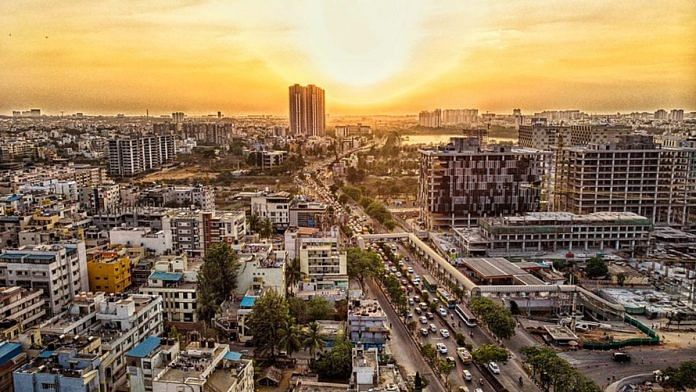Bengaluru: Bengaluru, which is fighting blistering heat and a water crisis, is bracing for a tough year and a tougher future. Recent studies have indicated that a majority of Bengaluru’s surface area has been concretised, and the latest analysis by Indian Institute of Science (IISc) researchers, made public last week, shows just how dire the situation is.
The researchers have found that over the past five decades, 93 percent of the city has lost its lake and forest cover to concrete and construction. There has been a 79 percent loss in water cover and 88 percent loss in forest cover while constructions have increased by over 1,000 percent. These latest revelations come as an acute water crisis is underway in Bengaluru. The city swelters under unnaturally high February and March heat every year, and last year, this was followed by intense flooding after minor rains.
When temperatures rise, concrete magnifies that effect, creating what is called an urban heat island, which can further boost temperature in cities.
Bengaluru residents and civic organisations have been tracking the city’s expansion and the growing urban sprawl via satellite imagery. Each year, the extent of greenery and the number of water bodies decrease in the city.
At this point, experts suggest policies that expand the city vertically and urban greening, among other measures.
Garden City missing forests
Two main types of ecosystem loss are prominent in the city — lakes and forests.
Known as Garden City, Bengaluru has historically been a green and cool city due to its higher altitude. As rapid urbanisation took over green spaces, the municipal body failed to keep proper records of the land under its jurisdiction, said Alok Prasanna Kumar, co-founder of Vidhi Centre for Legal Policy.
Since the 1970s, there has been a 1,000 percent increase in constructions in the city. Now, the green patches in the city are overwhelmingly government and military areas, which experience temperatures one to two degrees cooler than the rest of Bengaluru.
Apart from these regions, green government-owned parks or green belts are hardly found in public places or on paper or digital records.
Similarly, the city, which once contained dozens of lakes, contains only a handful now. The majority of water bodies have been filled in and constructed over by private companies. Increased concretisation leads to heat retention and has raised concerns that heat domes might become the norm around Bengaluru, exacerbating mercury readings.
Kumar said farmlands in the middle of the city have been turned into office complexes. “The BBMP (Bruhat Bengaluru Mahanagara Palike) needs to have better processes in place to maintain details about land ownership,” Kumar said. “There is a demand for land, which will not go away. How the demand is addressed now is what matters.”
The lack of greenery also leads to more pollutants in the air. Pollutants steadily increase as more and more information technology (I-T) parks come up, with rapid construction and a personal transport ecosystem developing around them.
Also read: Bengaluru has a difficult choice—save a 230-year-old stud farm or stay congested
Water crisis at play
The consequences of indiscriminate concretisation of the city are already at play. There is already a severe water crisis in several parts of the city this year and the wastage of water now incurs fines.
While there is a lack of water in summer, the monsoon reverses the situation. Constructions have overwhelmingly come up downslope, where water should drain. As a result, pooled water leads to road and street flooding.
“Bengaluru lakes, even if most are manmade, are fundamentally low-lying areas acting as storage for its catchment area. With all the concretisation and built infrastructure obstructing the flow, there is nowhere for rainwater to percolate into the ground or flow into lakes. With more intense rainfall, flooding is inevitable,” said Meera K., co-founder of civic media platform Citizen Matters.
Some roads might contain tiny channels to allow rainwater to flow through, but those are not strong enough to stand more powerful flows during heavy rains, which are now likely to become increasingly common.
Bringing back nature
Experts said the first solution is urban greening, i.e., creating parks and other green spaces.
Karnataka also has legal frameworks and policies for the urban environment, including the Karnataka Preservation of Tree Act (KTPA) of 1976, but land laws are often violated. This leads to illegal constructions and misuse of land, resulting in ecological repercussions.
“The city should now develop tall instead of wide,” said Kumar, also stressing the need for urban greenery. “All the high-rises today are located around the centre of the city. This has already led to water supply problems. Newer offices should build high-rises in the centre, which would help preserve a necessary green belt around the city.”
Meera K., too, stressed the need for more green spaces like parks or mini-forests, which can also function as open spaces for the public.
“We don’t have a well-designed master plan in place. Urban sprawl has made things worse — there is a huge peri-urban area being fully built up without the required infrastructure. Also, this mindset of paving everything impacts rainwater drainage and increases heat,” she said.
Kumar envisions tall complexes in the city with urban greenery as in countries like Singapore. When cities are designed like that, localities are friendly for walks and easy to access.
Some patches in Bengaluru, including the sides of highways, still have greenery, but the trees are often felled for expansion.
“The main thing is that existing green cover and lakes need to be protected. More authorities would probably be needed to implement the regulations,” said Kumar.
(Edited by Madhurita Goswami)
Also read: What led to Bengaluru water crisis? Unchecked concretisation coupled with lack of political will



